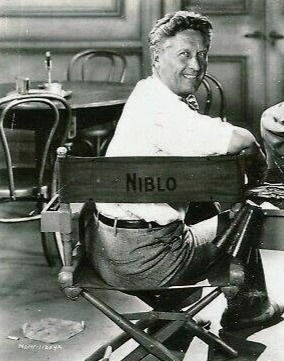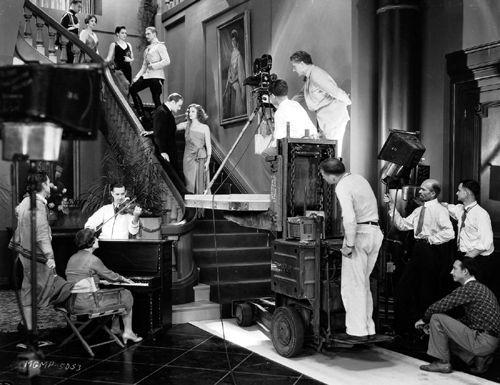Fred Niblo
- SilentCinemaSchool

- Jul 9, 2021
- 3 min read
Remember the royal bust of a movie, "Ben-Hur"? Well, today we're talking about the director who turned the mess into a masterpiece. Not only did he direct "Ben-Hur", he also directed some of the most popular films of the silent era. Distinguished readers, meet the man behind the camera....Fred Niblo.

1874 - 1948
IMDb: Fred Niblo - IMDb
Frederick Liedtke was born in Nebraska, to French parents. His father had been a soldier in the Civil War. As a young man, Fred began using the stage name "Fred Niblo", the last name being the actual last name of a theater owner where Fred had worked the most. He was a successful vaudeville and theatre performer for over 20 years! He also managed a successful vaudeville act known as "The Four Cohans" (one of the Four Cohans was his wife, Josephine). His work took him to many different places around the world, and in 1912 he landed in Australia.

Young Fred (year unknown)
A lot happened for Fred in Australia, particularly in 1916. For one thing, he got involved with motion pictures as an actor. Fred was in 2 films there, and met an actress that he would marry in a few years, Enid Bennett. Sadly, Josephine passed away the same year. You ever have one of those years where EVERYTHING happens all at once....? Can we just, like....spread that out a lil' more evenly...??

ABOVE: Fred (front right) with Douglas Fairbanks and Mary Pickford, on the set of "The Three Musketeers" (1921)

ABOVE: Movie poster for "Blood and Sand" (1922)
In 1917, Fred returned to the United States and began working as a producer-director for early Hollywood mogul Thomas Ince. In the style of our feisty Irish friend Rex Ingram, many of Fred's earlier films starred his (new) wife, Enid. Eventually, Fred began working at Paramount Pictures (where Jesse L. Lasky was boss), as well as United Artists (founded by Mary Pickford and Douglas Fairbanks). He made a string of successful films in the early 1920's that are still popular among silent film aficionados: "The Mark of Zorro", "The Three Musketeers" and "Blood and Sand" with Rudolph Valentino! After working with Rudy, Fred said:
"Valentino is one of the most sensitive, responsive actors with whom it has ever been my good fortune to work. He has a remarkable instinct for acting which makes his characterization of Gallardo, the bull fighter, stand out as the best work he has ever done."

ABOVE: Fred giving direction to actress Carmel Myers in "Ben-Hur" (1925)
....AND THEN. CAME. "BEN-HUR". Oh yes, it did. By now, Fred had a contract with the newly-formed MGM. Studio head Louis B. Mayer (a man you'd love to hate), was pulling his hair out over the mess that had become of the film written and co-produced by the brilliant June Mathis. Shooting in Italy was a bad call, as you might remember. Anyways, Louis sent Fred overseas to replace the current director and do what he could with the movie. Long story short, Fred turned the project around and it became the third highest-grossing film in cinema history - although it still didn't turn a profit due to all the ah....problems. Well, you can't win 'em all, Fred.

ABOVE: Fred and Enid (1926)

ABOVE: Fred (center), giving direction to Lillian Gish in "The Enemy" (1927)

ABOVE: Fred (next to cameraman), shooting Greta Garbo in a scene from "The Mysterious Lady" (1928)
Although Fred made the transition to sound, the 1920s were his heyday. He followed "Ben-Hur" with several other notable silent films, and was one of the 36 original founders of the Academy of Motion Picture Arts and Sciences! In 1933, Fred retired after more than 40 years in the entertainment industry. In 1940, he appeared in several films (as an actor in small parts), but was unable to keep himself financially sustained. That same year, Fred sold his custom-built hilltop home in the Beverly Glen area of Los Angeles, which he and Enid had named "Misty Mountain", and (as many big names of the silent era did) slipped into obscurity.

In 1948, Fred passed away in New Orleans, Louisiana. We're not sure why he was there - there's a lot of "holes" in his story! He was laid to rest in Glendale, California. He was survived by his wife Enid and their 4 children. His son, Fred Jr., became a successful screenwriter!
Actress Marion Schilling once said of Fred:
"One of the reasons for his success as a director, certainly, was that he had been an actor himself. He could empathize, see and feel a scene from an actor's viewpoint. He never talked down to us. He was a lovely human being."
Excellent words to be remembered by! Have a look at one of his triumphs (The Mark of Zorro) below!
Resources:


.png)



Comments